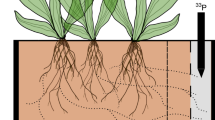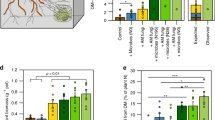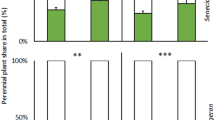Abstract
VESICULAR-ARBUSCULAR mycorrhizal fungi infect most higher plants and usually increase plant growth and phosphorus uptake, especially in infertile soils1. Mosse2–4 has shown that the indigenous mycorrhizal fungi in some soils are very infective but much less efficient in stimulating phosphorus uptake and plant growth than selected mycorrhizal fungi maintained in glasshouse pot culture. New Zealand soils have a short history of pastural agriculture (<150 yr) and still range in fertility from very phosphorus-deficient podocarp–broadleaf forest soils to well developed and highly fertile pasture soils. Most hill country pastures consist of introduced grasses and legumes which are invariably mycorrhizal5,6. These pastures have been developed within the past 100 yr from infertile forest soils in which nearly all plants were mycorrhizal7 and many were completely dependent on mycorrhizal infection for phosphate uptake and plant growth8,9. Many forests are still being cleared and brought into pasture by oversowing with white clover and spreading heavy dressings of superphosphate. It is important to know whether the indigenous mycorrhizal fungi adapted to these infertile forest soils are as effective at stimulating clover growth in highly fertilised pastures as an efficient mycorrhizal fungus such as E3 (ref. 10), a Glomus species from Mosse's Rothamsted collection.
This is a preview of subscription content, access via your institution
Access options
Subscribe to this journal
Receive 51 print issues and online access
$199.00 per year
only $3.90 per issue
Buy this article
- Purchase on Springer Link
- Instant access to full article PDF
Prices may be subject to local taxes which are calculated during checkout
Similar content being viewed by others
References
Mosse, B., A. Rev. Phytopath., 11, 171–196 (1973).
Mosse, B., Hayman, D. S., and Ide, G. J., Nature, 224, 1031–1032 (1969).
Mosse, B., and Hayman, D. S., New Phytol., 70, 29–34 (1971).
Mosse, B., in Endomycorrhizas (Academic London, 1975).
Crush, J. R., N.Z. J. Bot., 11, 645–660 (1973).
Crush, J. R., N.Z. J. agric. Res., 18, 361–364 (1975).
McNabb, R. F. R., thesis, Otago Univ., New Zealand (1958).
Baylis, G. T. S., New Phytol., 66, 231–243 (1967).
Baylis, G. T. S., in Endomycorrhizas (Academic, London, 1975).
Mosse, B., Powell, C. L., and Hayman, D. S., New Phytol., 76, 331–342 (1976).
Phillips, J. M., and Hayman, D. S., Trans, Br. mycol. Soc., 55, 158–161 (1970).
Mountier, N. S., Grigg, J. L., and Oomen, G. A. C., N.Z. J. agric. Res., 9, 328–338 (1966).
Author information
Authors and Affiliations
Rights and permissions
About this article
Cite this article
POWELL, C. Mycorrhizal fungi stimulate clover growth in New Zealand hill country soils. Nature 264, 436–438 (1976). https://doi.org/10.1038/264436a0
Received:
Accepted:
Issue Date:
DOI: https://doi.org/10.1038/264436a0
Comments
By submitting a comment you agree to abide by our Terms and Community Guidelines. If you find something abusive or that does not comply with our terms or guidelines please flag it as inappropriate.



